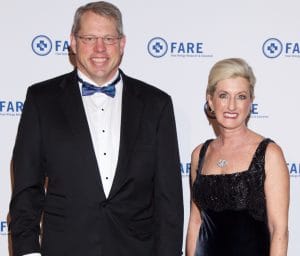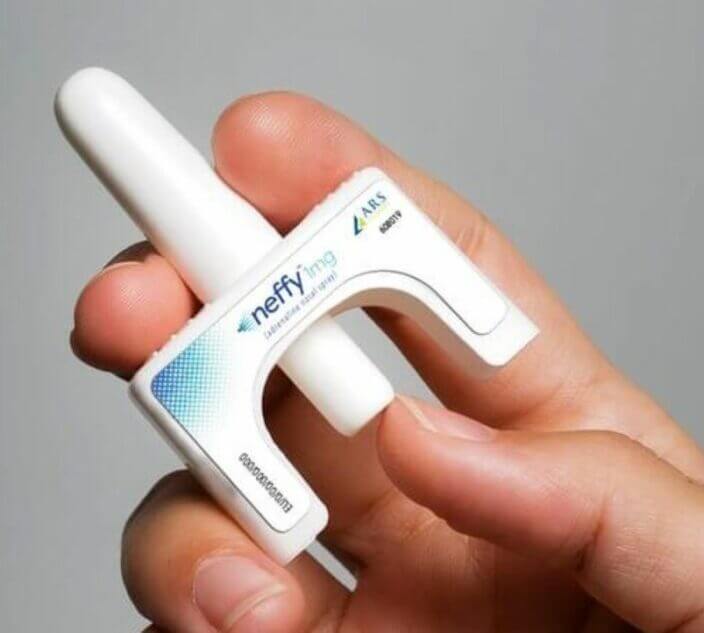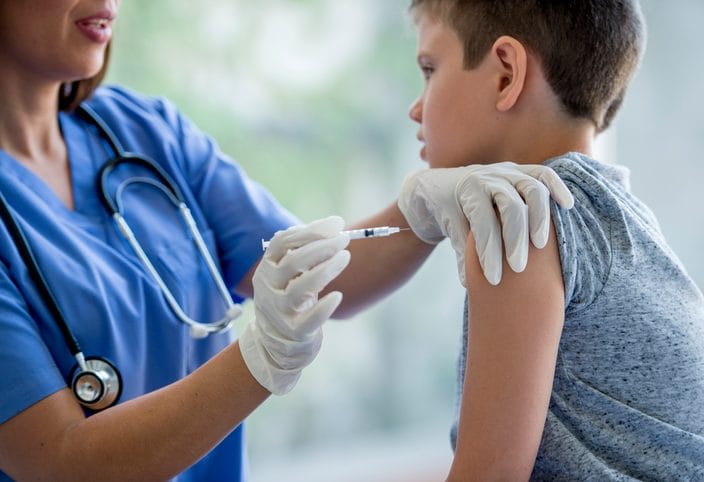 David Bunning
David Bunning To learn more about the precise goals of the new campaign, Allergic Living Editor Gwen Smith spoke this week to David Bunning, chair of FARE’s board of directors. Bunning, founder and CEO of The TLP Group, and his wife Denise Bunning are longtime advocates and philanthropic supporters of food allergy. They were involved with the Food Allergy Initiative, which later merged with FAAN to become today’s FARE. The Bunnings have two young-adult sons who have multiple, severe food allergies.
The campaign called “Contains Courage” is the biggest ever launched for food allergy. Can you tell us why it’s launching – and why now?
David Bunning: Yes. Food allergies affect 8 percent of children in the latest statistics and, in my travels, it’s rare that I’m in a meeting where someone else isn’t personally affected by food allergy. This is a large, national problem and the statistics reveal that it’s now two kids affected per classroom. At the large medical centers, they’re seeing as many or more food allergy visits as other allergic diseases combined. So it’s easy to wrap your head around where food allergy is today.
But this has emerged rapidly vis-a-vis 30 years ago. Today, you can put a thousand people in a room and ask how many know more than a couple families affected by food allergies, and it’s almost everybody. Something big has happened in a short period of time, and the resources that have gone into food allergy just haven’t caught up. So we’re left with a very big problem that’s severely under-resourced.
Fifteen years ago, when Denise and I first started working on food allergy, the NIH [National Institutes of Health] was putting $4 million dollars into food allergy research, $300 million into asthma and $1 billion into diabetes. So food allergy was a little above 1 percent of asthma and a fraction of a percent of diabetes. The base that food allergy started at was so small, and it’s so complex and expensive to come up with diagnostics and therapeutics, that food allergy has been in a game of catch-up, for the last 15 or 20 years as the prevalence has increased.
So why [the campaign] today? It seems – and the board of FARE and [CEO] Lisa Gable agree – that prevalence is such and it’s affecting every socio-economic group; it affects everybody.
In terms of the scale of health-related campaigns, this is actually a modest one. If you look at the revenues of other national not-for-profits involved in diseases, a five-year, $200 million campaign is not particularly large.
In introducing the campaign, FARE CEO Lisa Gable spoke of being “at an inflection point, when new innovations poised to positively impact families are on the horizon.” Is this largely a research campaign that you two are speaking about, as opposed to an education and awareness effort?
DB: It’s across the board, and they all work together. The campaign goal is to improve the lives of food-allergic children. This includes awareness, it will include work on improved policies, work on better diagnostics and therapies.
We think this is the opportunity to reach across the country and engage families from East Coast to West Coast and from north to south and get a dialogue among all of us affected to make a difference in what currently happens with a diagnosis for food allergy. And that is allergen avoidance and a prescription for EpiPens – this clearly isn’t acceptable. The latest statistic is an emergency room visit every three minutes for food allergy in the United States. So the “avoid” approach just doesn’t work. I know this from our own family’s experience with multiple accidental reactions and trips to the emergency room.
Something has to be done about this, and we’re at the point where the first-generation of therapies are starting to mature and become possible. Then there’s the potential for the next generation and ultimately, down the road, a cure. We think by drawing a proactive roadmap for research and communication that there’s a great opportunity to have all the constituents come together to work on a larger initiative.
You reference the first therapies that will be reviewed for FDA approval. What do you see coming next for food allergy treatment? Will it be more treatments toward desensitization, or do we need to be striving for the holy grail of a cure?
DB: There’s the short, the intermediate and the long-term. The short-term is we want improve quality of life for children and adults that are affected. So that would include addressing their day-to-day life and how they interact with schools, how they interact with restaurants, how they interact in their daily activities, and how they’re perceived by the general public. There’s a lot of work even in lack of understanding with the general public on just how hard it is to avoid a food.
Then, people familiar with food allergies know that the diagnostics [tests] that are currently used are imprecise and, ultimately, the diagnostic that can be used as a final determinant is the [oral] food challenge. The thought that in 2018 you use a food challenge to determine how allergic somebody is – whether it’s for a clinical trial or for other purposes – it seems we could do better than that with modern science. What’s needed is funding to develop a better diagnostic and then to get institutional interest to turn it into a product.
Then obviously from the current therapies that are in the pipeline, the medium-term goal would be to have some protection from accidental exposure for all allergens. And the long-term [goal] would be a treatment that allows for ingestion with tolerance.
Ingestion with tolerance. So in other words, the term researchers try to avoid – “a cure” – this is the long-term goal?
DB: I would hope it would be, yes.
Those who follow food allergy research have come to understand that the immune system is a complex beast. So people sometimes ask: ‘If we throw money at this, will that ever get us to a cure?’ What encourages you to think it is within the realm of possibility?
 David Bunning, chair of FARE's board of directors, and Lisa Gable, FARE CEO, at the Food Allergy Ball in early December.
David Bunning, chair of FARE's board of directors, and Lisa Gable, FARE CEO, at the Food Allergy Ball in early December. And so, with funding, food allergy can follow in the footsteps of work that has been done in other diseases and, we believe, move the understanding of food allergy forward fairly rapidly given how little investment there has been to date in it.
There is more pharmaceutical interest in food allergy than there has ever been, and with technology moving so quickly in these other disease fields, I think the hope for food-allergy affected families couldn’t be greater. The opportunities are out there to answer the questions, we just need to fund systematic, large-scale studies to create enough data that we can figure out what some the origins are of the disease.
Would those be studies then done with FARE along with NIH backing or how would that work?
DB: We’re looking to partner across the country. That’s with medical centers and obviously governmental bodies as well, including the NIH. It takes a village. And the goal again is to is to get an understanding across the field on what the important questions are that need to get answered, and work together to make sure that we can answer them.
Does FARE’s Clinical Network come into play in this type of collaborative effort?
DB: Absolutely. It’s the Clinical Network and beyond. FARE is trying to reach out and engage scientific leaders across the country and to learn what they think are the most important questions to answer and the most efficient ways to answer those questions.
On a personal note, you have put a lot of years, and a lot of money and effort into food allergy research. Why is this so critically important to you and your wife Denise?
DB: It started obviously with our children being affected, but it very, very quickly became much larger than that when we realized how little was being put into food allergy relative to other diseases. [He reminds of the funding levels of asthma, diabetes and cancer from 15 years ago.] There’s no way to solve a problem without resources. And when we realized that it was a big and national problem, that every school was seeing the disease, that there was a big misperception by the general public on how hard it is to avoid a food, and the amount stress on the family and child in trying to avoid a food, Denise and I had to try to help.
Where do you hope food allergy will be a year from now?
DB: [We’re looking to have] a national coalition, involving FARE and many, many medical centers and many families, and hopefully with input and interest from the pharmaceutical industry and the NIH, with a number of initiatives moving forward to try to answer some of the basic questions.
[Among the questions]: Is there a better diagnostic and what might that be to eliminate the number of food challenges? The first-generation of [peanut] therapies, how do we broaden them to all allergens and standardize them in way that there’s some agreement on how they should be applied? And then, what are the critical studies that need to be done to create answers as to what might be the pathway to more elegant therapies?
Co-operation is the key; it’s getting the 31 Clinical Network sites and many more along with their supporters and constituents to all understand what needs to be done to progress past just being given a prescription for an auto-injector.
Any last thoughts about the campaign to share with the community?
DB: Lisa Gable’s leadership in working in policy and advocacy and on national issues, combined with a philosophy of reaching out to include families and institutions throughout the country to work together to improve quality of life for food-allergic families, that’s the goal and it’s very exciting. As we travel the country, people see that the current state of food allergy [avoidance] is just not acceptable, and that by putting investment into the disease and utilizing technologies that have been advanced other areas of immunology, that the opportunity is there to improve the quality of life for food-allergic children.
I also mentioned improving lives today. That involves making sure the entire country understands what food allergy is, the challenge of avoiding a food, and the impact that just trying to avoid a food every day can have on a family is important. So the awareness piece goes right along with it.
Thank you for this conversation. The food allergy community will appreciate this information and learning about the new FARE campaign.
DB: Thank you.
See FARE’s ‘Contains Courage’ campaign video here.





